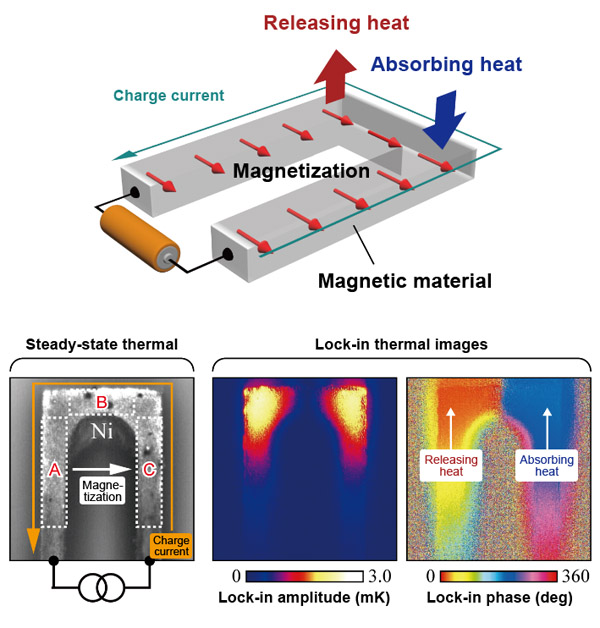Observation of the anisotropic magneto-Peltier effect: Temperature of Magnetic Materials Can be Manipulated through Simple Redirection of Charge Current
—Novel Heating/Cooling Function Demonstrated Using a Single Magnetic Material without Junction Structure—
2018.05.22
National Institute for Materials Science (NIMS)
Tohoku University
Japan Science and Technology Agency (JST)
For the first time in the world, NIMS and Tohoku University jointly observed an anisotropic magneto-Peltier effect—a thermoelectric conversion phenomenon in which simple redirection of a charge current in a magnetic material induces heating and cooling.
Abstract
- For the first time in the world, NIMS and Tohoku University jointly observed an anisotropic magneto-Peltier effect—a thermoelectric conversion phenomenon in which simple redirection of a charge current in a magnetic material induces heating and cooling. Thermoelectric heating and cooling are conventionally achieved by applying a charge current to a junction between two different electrical conductors. In this research, we demonstrated a novel thermal control function using a single magnetic material without relying on a junction structure. Although the anisotropic magneto-Peltier effect is one of the fundamental thermoelectric conversion phenomena, it remained to be observed. We hope that this report will stimulate further advances in basic and applied research on thermoelectric conversion.
- Conversion between charge and heat currents can be achieved in metals and semiconductors by means of the thermoelectric effect. A well-known example of the conversion is the Peltier effect, whereby a conductor can be heated or cooled by applying a charge current. Although the Peltier effect was discovered almost 200 years ago, global research activities on this subject remain active today in an effort to increase the thermoelectric conversion efficiency in electronic devices and apply this phenomenon to a wider range of technologies (e.g., development of more energy-efficient computers).
- The NIMS-led research team used a thermal measurement technique called lock-in thermography to make systematic measurements of temperature changes in a magnetic material while a charge current was applied. As a result, we observed changes in the Peltier coefficient in relation to the angle between the direction of the charge current and the direction of the magnetization in the magnetic material. It has been previously observed that the Seebeck effect—a phenomenon in which a temperature difference between a conductor produces a charge current—changes in relation to the direction of magnetization; this is called the anisotropic magneto-Seebeck effect. However, the anisotropic magneto-Peltier effect, which is the reciprocal of the anisotropic magneto Seebeck effect, had not been observed before this research.
- Application of the anisotropic magneto-Peltier effect may enable thermoelectric temperature control of a magnetic material by simply redirecting a charge current in the material and creating a non-uniform magnetization configuration within it, rather than forming a junction between two different electrical conductors. In future studies, we will attempt to identify and develop magnetic materials that exhibit large anisotropic magneto-Peltier effects and apply them to the development of thermal management technologies that make electronic devices energy-efficient.
- This research project was carried out by Ken-ichi Uchida (Group Leader, Spin Caloritronics Group, Research Center for Magnetic and Spintronic Materials, NIMS), Ryo Iguchi (Researcher, Spin Caloritronics Group, Research Center for Magnetic and Spintronic Materials, NIMS), Shunsuke Daimon (Graduate Student, Institute for Materials Research and Advanced Institute for Materials Research, Tohoku University; currently Assistant Professor of The University of Tokyo), and Eiji Saitoh (Professor, Institute for Materials Research and Advanced Institute for Materials Research, Tohoku University; currently Professor of The University of Tokyo).This project was supported mainly by the JST Strategic Basic Research Program CREST (JPMJCR17I1) and the JSPS Grant-in-Aid for Scientific Research (A) (JP15H02012).
- This research was published in the online version of the British scientific journal Nature at 12:00 am on May 22, 2018, Japan Time (4:00 pm on May 21, GMT).

Figure. Experimental configuration for measuring the anisotropic magneto-Peltier effect and lock-in thermal images of a U-shaped ferromagnet.
Related files
- Research Center for Magnetic and Spintronic Materials
Contacts
(Regarding this research)
-
Ken-ichi Uchida
Group Leader, Spin Caloritronics Group
Research Center for Magnetic and Spintronic Materials
National Institute for Materials Science
Tel: +81-29-859-2062
Fax: +81-29-859-2701
E-Mail: UCHIDA.Kenichi=nims.go.jp
(Please change "=" to "@")
(For general inquiries)
-
Public Relations Office
National Institute for Materials Science
1-2-1 Sengen, Tsukuba, Ibaraki 305-0047, Japan
Tel: +81-29-859-2026
Fax: +81-29-859-2017
E-Mail: pressrelease=ml.nims.go.jp
(Please change "=" to "@") -
Public Relations and Outreach Office
Advanced Institute for Materials Research
Tohoku University
Tel: +81-22-217-6146
Fax: +81-22-217-5129
E-Mail: aimr-outreach=grp.tohoku.ac.jp
(Please change "=" to "@") -
Public Relations Division
Department of General Affairs
Japan Science and Technology Agency
5-3 Yonbancho, Chiyoda-ku, Tokyo 102-8666, Japan
Tel: +81-3-5214-8404
Fax: +81-3-5214-8432
E-Mail: jstkoho=jst.go.jp
(Please change "=" to "@")
(Regarding the JST Strategic Basic Research Programs)
-
Tsuyoshi Nakamura
Green Innovation Group
Department of Innovation Research
Japan Science and Technology Agency
K's Gobancho, 7 Gobancho, Chiyoda-ku, Tokyo 102-0076, Japan
Tel: +81-3-3512-3531
Fax: +81-3-3222-2066
E-Mail: crest=jst.go.jp
(Please change "=" to "@")
Same Keywords
-
World’s First Observation of the Transverse Thomson Effect
(thermoelectric conversion)
2025.06.26
-
Proof-of-principle demonstration of 3-D magnetic recording
(Tohoku University)
2024.03.27
-
Miniaturization of a Thermoelectric Device Capable of Powering IoT Products
(thermoelectric conversion)
2022.06.23
